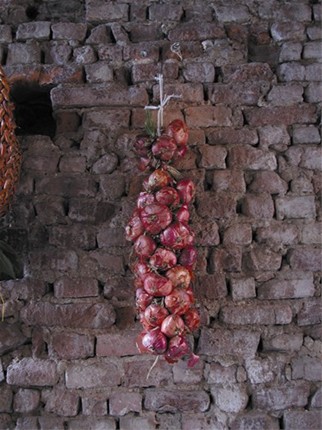Zuppa di Cipolla: rossa e sopratutto… toscana!Onion soup; red and above all…Tuscan!
 Quando si parla di zuppa di cipolle, una sola è la certezza: ogni nazione, ogni regione, e all’interno di ogni regione diciamo pure ogni zona possiede una propria ricetta.
Quando si parla di zuppa di cipolle, una sola è la certezza: ogni nazione, ogni regione, e all’interno di ogni regione diciamo pure ogni zona possiede una propria ricetta.
Fra le tante versioni più famose ricordiamo soprattutto la fiorentinissima “carabaccia” e la popolarissima “soupe à l’oignon” francese. Il nome della prima della zuppa fiorentina pare derivi dal termine greco “karabos”, che vuol dire barca a forma di guscio, forse a ricordare la forma della zuppiera.
Questa ricetta è riportata più volte nei ricettari a partire dal 1500 col nome più antico di “carabazada”. Responsabile della sua grande fama, giunta fino ai giorni nostri, fu Caterina dei Medici – nipote di Lorenzo il Magnifico – che andò sposa nel 1533, al secondogenito del re di Francia. Con il proprio corredo Caterina trasferì a Parigi anche i migliori cuochi fiorentini della corte medicea e con loro rinnovò praticamente la cucina di corte francese.
Addirittura, spingendoci oltre, si può anche asserire che la francesissima “soupe à l’oignon” sia semplicemente “figlia” della carabaccia fiorentina; un piatto ricco di spezie e di sapori in cui, come andava di moda a quel tempo, il dolce si unisce al salato.
Nella ricetta originale figurano infatti, oltre ovviamente alle cipolle rosse, anche mandorle, cannella, zucchero e aceto d’agresto. La ricetta che vi proponiamo è una delle molte varianti odierne della Carabaccia.
Ingredienti: (per 6 persone)
1 Kg. di cipolle rosse, sedano, carota, sale, pepe, olio extra vergine d’oliva, pane abbrusstolito, brodo
La ricetta:
Prendere le cipolle rosse e tagliarle (dopo aver tolto la prima pelle) a fette sottili; metterle insiema ad un trito di sedano, carota, sale e pepe a cuocere in un tegame profondo con circa mezzo bicchiere d’olio extra vergine d’oliva. Farle cuocere, rimestandole, per circa un ora, aggiungendo solo a fine cottura se vediamo che stanno per attaccarsi, un po’ di brodo.
Due sono i modi di servirla: direttamente su fette di pane arrostite e bagnate nel brodo; oppure diluita con altro brodo e servita sulle solite fette di pane con aggiunta di formaggio pecorino grattugiato. When we talk about onion soup we can only be sure of one thing; each nation, each region and each little area has its own recipe.
When we talk about onion soup we can only be sure of one thing; each nation, each region and each little area has its own recipe.
Among all the famous versions there are the very Florentine “Carabaccia” and the very popular French “soupe à l’oignon”.
The name of the Florentine soup seams to come from the Greek word “karabos” describing a boat with the form of a husk, maybe to recall the form of the tureen. This recipe can be found in several cookbooks ever since the 1500 under the more antique name “carabazada”.
Its great fame is due to Canterina dei Medici- the niece of Lorenzo the Magnificent – who married the second born son of the king of France in 1533. When she moved to Paris she brought along also the best Florentine cooks from the Medicean court that had a great influence on the French court cuisine.
In some way you could even say that the very French “soupe à l’oignon” is just the “daughter” to the Florentine Carabaccia; a dish rich of spices and flavours mixing sweet and salt, according to the cooking trend at the time.
In the original recipe, a part from the red onions, there are almonds, cinnamon, sugar and vinegar. The recipe that we would like to suggest is just one of the many existing variants of the Carabaccia.
Ingredients:
Serves 6
1 kg red onions, celery, carrots, salt, pepper, extra virgin olive oil, toasted bread and broth.
Recipe:
Cut the red onions in thin slices, mix it with the chopped celery, carrots, salt and pepper and let it cook in a deep pan with about a half glass of extra virgin olive oil. Let it cook for about an hour stirring once in a while. When it’s almost ready add some broth if necessary. The soup is served on slices of toasted bread dipped in the broth with or without pecorino cheese on top.
